Residents’ Attitudes towards Wooden Facade Renovation and Additional Floor Construction in Finland
Abstract
:1. Introduction
- How do residents react to the timber facade renovation and additional floor construction?
- How do wooden facade renovation and additional floor construction affect the attractiveness of residential areas?
- What are the participants’ preferences regarding additional construction issues?
- How do residents perceive different wood renovation alternatives?
2. Research Methods
| # | Part | Explanation |
|---|---|---|
| 1st | A | After the participants were introduced to the topic with a series of pictures from the questionnaire, they were asked to describe their attitude towards wooden facade renovation at a general level. A Likert-type scale was used ((1) negatively to (5) positively). Here “I don’t know” option was also provided. |
| 2nd | B | Using the same Likert-type scale in Part A, they were asked to explain their attitude towards additional floor construction. |
| 3rd | C | Residents were asked to describe their opinions on the combination of wooden facade renovation and additional floor construction. Another Likert-type scale was used ((1) completely disagree to (5) completely agree). Here “I don’t know” was provided, too. |
| 4th | D | Participants were asked about their preferences for additional construction (e.g., with an additional floor, new outbuildings) in residential areas. |
| 5th | E | Respondents who own an apartment were asked to indicate how they would react if their housing association decided to build an additional wooden floor to finance the renovation of the facade by using the same Likert type scale in Part A and B to improve the features that respondents considered to be a failure in a suburban apartment building. Participants were allowed to provide feedback on facade renovation and additional floor construction in open responses. |
| 6th | F | Residents surveyed were presented with a series of six pictures of wood facade renovation and additional floor construction projects implemented in a typical Finnish suburban apartment building in the 1970s, as seen in Figure 2. The initial situation of the suburban apartment building before the renovation was shown first in the series picture (Image 1). Images 2–5 of the series were visualization images of possible wooden facade renovation and additional floor implementations, all of which are based on the typical suburban apartment building of Image 1. Participants were asked to look at pictures of facade renovation and additional floor construction and then rate them. School grading scale (from 4 (I don’t like the look of the building and I have a negative attitude like this building) to 10 (appearance of the building is beautiful and I welcome this building)) was employed. |
3. Findings
3.1. Residents’ Attitude towards Wooden Facade Renovation
3.2. Residents’ Attitude towards Wooden Additional Floor Construction
3.3. Effect of Wooden Facade Renovation and Additional Floor Construction on the Attractiveness of Residential Areas
3.4. Residents’ Preferences for Additional Construction
3.5. Attitudes of Apartment Building Owners towards Their Own Housing Company’s Wooden Additional Floor Project to Finance Facade Renovation
3.6. Residents’ Attitudes towards Different Wooden Renovation Alternatives
4. Discussion
5. Conclusions
Author Contributions
Funding
Institutional Review Board Statement
Informed Consent Statement
Data Availability Statement
Conflicts of Interest
References
- The European Climate Foundation (ECF). Roadmap 2050. Available online: https://www.roadmap2050.eu/ (accessed on 18 November 2021).
- Allard, I.; Nair, G.; Olofsson, T. Energy performance criteria for residential buildings: A comparison of Finnish, Norwegian, Swedish, and Russian building codes. Energy Build. 2021, 250, 111276. [Google Scholar] [CrossRef]
- Kuittinen, M.; Häkkinen, T. Reduced carbon footprints of buildings: New Finnish standards and assessments. Build. Cities 2020, 1, 182–197. [Google Scholar] [CrossRef]
- Simson, R.; Fadejev, J.; Kurnitski, J.; Kesti, J.; Lautso, P. Assessment of Retrofit Measures for Industrial Halls: Energy Efficiency and Renovation Budget Estimation. Energy Procedia 2016, 96, 124–133. [Google Scholar] [CrossRef]
- European Commission. Long-Term Renovation Strategy 2020–2050 Finland, Report According to Article 2a of Directive (2010/31/EU) on the Energy Performance of Buildings, as Amended by Directive 2018/844/EU. 10 March 2020. Available online: https://ec.europa.eu/energy/sites/default/files/documents/fi_2020_ltrs_en.pdf (accessed on 18 November 2021).
- Kaasalainen, T.; Huuhka, S. Homogenous homes of Finland: ‘standard’ flats in non-standardized blocks. Build. Res. Inf. 2016, 44, 229–247. [Google Scholar] [CrossRef]
- Hirvonena, J.; Jokisaloa, J.; Heljo, J.; Kosonena, R. Towards the EU emissions targets of 2050: Optimal energy renovation measures of Finnish apartment buildings. Int. J. Sustain. Energy 2018, 38, 1–24. [Google Scholar] [CrossRef] [Green Version]
- The Housing Finance and Development Centre of Finland (ARA), The Suburban Innova Block of Flats Is Being Renovated into a Passive House. Available online: https://www.ara.fi/en-US/Housing_development/Development_projects/The_suburban_Innova_block_of_flats_is_be%2817681%29 (accessed on 18 November 2021).
- Soikkeli, A.; Sorri, L. A New Suburb Renovation Concept’. World Academy of Science, Engineering and Technology, Open Science Index 90. Int. J. Archit. Environ. Eng. 2014, 8, 647–655. [Google Scholar]
- Soikkeli, A.; Hagan, H.; Karjalainen, M.; Koiso-Kanttila, J.; Kurnitski, J.; Viljakainen, M.; Hotakainen, T.; Jäntti, T.; Murtonen, N.; Sakki, R.; et al. Puun Mahdollisuudet Lähiöiden Korjauksessa; Arkkitehtuurin Osasto, Oulun Yliopisto: Oulu, Finland, 2011; Available online: https://www.oulu.fi/ark/tiedostot/puun_mahdollisuudet_lahioiden_korjauksissa_web.pdf (accessed on 18 November 2021). (In Finnish)
- Huttunen, H.; Blomqvist, E.; Ellilä, E.; Hasu, E.; Perämäki, E.; Tervo, A.; Verma, I.; Ullrich, T.; Utriainen, J. The Finnish Townhouse as a Home. Starting Points and Interpretations; Habitat Components—Townhouse. Final Report; Aalto University Publication Series CROSSOVER 8/2017; Aalto University: Helsinki, Finland, 2017; Available online: https://aaltodoc.aalto.fi/bitstream/handle/123456789/30185/isbn9789526071220.pdf?sequence=1&isAllowed=y (accessed on 18 November 2021).
- The Finnish Timber of Council (Puuinfo). Available online: https://puuinfo.fi/?lang=enç (accessed on 18 November 2021).
- Official Statistics of Finland (OSF). Homeowners and Housing Companies Repaired by EUR 6.0 Billion in 2019. 2019. Available online: http://www.stat.fi/til/kora/2019/01/kora_2019_01_2020-06-11_tie_001_fi.html%20 (accessed on 18 November 2021).
- Streimikiene, D.; Balezentis, T. Innovative Policy Schemes to Promote Renovation of Multi-Flat Residential Buildings and Address the Problems of Energy Poverty of Aging Societies in Former Socialist Countries. Sustainability 2019, 11, 2015. [Google Scholar] [CrossRef] [Green Version]
- Paiho, S.; Abdurafikov, R.; Hoang, H.; Castell-Rüdenhausen, M.Z.; Hedman, Å.; Kuusisto, J. Business Aspects of Energy Efficient Renovations of Sovietera Residential Districts A Case Study from Moscow; VTT Technology 154 ISSN-L 2242-1211 ISSN 2242-122X (Online); VTT Technical Research Centre of Finland: Espoo, Finland, 2014; Available online: https://www.vttresearch.com/sites/default/files/pdf/technology/2014/T154.pdf (accessed on 18 November 2021).
- United Nations Human Settlements Programme, United Nations Economic Commission for Europe. Good Practices for Energy-Efficient Housing in The Unece Region; United Nations: New York, NY, USA; Geneva, Switzerland, 2013; Available online: https://unece.org/fileadmin/DAM/hlm/documents/Publications/good.practices.ee.housing.pdf (accessed on 18 November 2021).
- Soikkeli, A. Additional Floors in Old Apartment Blocks. Energy Procedia 2016, 96, 815–823. [Google Scholar] [CrossRef] [Green Version]
- Huuhka, S.; Vainio, T.; Moisio, M.; Lampinen, E.; Knuuttinen, M.; Bashmakov, S.; Köliö, A.; Lahdensivu, J.; Ala-Kotila, P.; Lahdenperä, P. To Demolish or to Repair? Carbon Footprint Impacts, Life Cycle Costs and Steering Instruments. Publications of the Ministry of the Environment 2021:9. Built Environment. 2021. Available online: https://julkaisut.valtioneuvosto.fi/bitstream/handle/10024/162862/YM_2021_9.pdf?sequence=4&isAllowed=y (accessed on 18 November 2021).
- Bojić, M.; Miletić, M.; Malešević, J.; Djordjević, S.; Cvetković, D. Influence of additional storey construction to space heating of a residential building. Energy Build. 2012, 54, 511–518. [Google Scholar] [CrossRef]
- Lammert, L. Circular Economy in Architecture—Sustainable Principles for Future Design. Master’s Thesis, Oulu School of Architecture, Faculty of Technology, University of Oulu, Oulu, Finland, 2018. Available online: https://figbc.fi/wp-content/uploads/sites/4/2020/05/nbnfioulu-201811233096.pdf (accessed on 18 November 2021).
- Soikkeli, A. Possibilities in the Renovation of Suburban Apartment Buildings. Case: Porvoonportti. In Improving the Quality of Suburban Building Stock; COST Action TU0701; Unifepress: Ferrara, Italy, 2012; pp. 127–140. [Google Scholar]
- Franzini, F.; Toivonen, R.; Toppinen, A. Why Not Wood? Benefits and Barriers of Wood as a Multistory Construction Material: Perceptions of Municipal Civil Servants from Finland. Buildings 2018, 8, 159. [Google Scholar] [CrossRef] [Green Version]
- Hart, J.; D’Amico, B.; Pomponi, F. Whole-life embodied carbon in multistory buildings: Steel, concrete and timber structures. J. Ind. Ecol. 2021, 25, 403–418. [Google Scholar] [CrossRef]
- Churkina, G.; Organschi, A.; Reyer, C.P.O.; Ruff, A.; Vinke, K.; Liu, Z.; Reck, B.K.; Graedel, T.E.; Schellnhuber, H.J. Buildings as a global carbon sink. Nat. Sustain. 2020, 3, 269–276. [Google Scholar] [CrossRef]
- Robati, M.; Oldfield, P.; Nezhad, A.A.; Carmichael, D.G.; Kuru, A. Carbon value engineering: A framework for integrating embodied carbon and cost reduction strategies in building design. Build. Environ. 2021, 192, 107620. [Google Scholar] [CrossRef]
- Pierobon, F.; Huang, M.; Simonen, K.; Ganguly, I. Environmental benefits of using hybrid CLT structure in midrise non-residential construction: An LCA based comparative case study in the U.S. Pacific Northwest. J. Build. Eng. 2019, 26, 100862. [Google Scholar] [CrossRef]
- Ritter, M.; Skog, K.; Bergman, R. Science Supporting the Economic and Environmental Benefits of Using Wood and Wood Products in Green Building Construction; General Technical Report FPL-GTR-206; Forest Products Laboratory, Forest Service, U.S. Department of Agriculture: Madison, WI, USA, 2011; pp. 1–9.
- Dong, Y.; Qin, T.; Zhou, S.; Huang, L.; Bo, R.; Guo, H.; Yin, X. Comparative Whole Building Life Cycle Assessment of Energy Saving and Carbon Reduction Performance of Reinforced Concrete and Timber Stadiums—A Case Study in China. Sustainability 2020, 12, 1566. [Google Scholar] [CrossRef] [Green Version]
- Bergman, R.; Puettmann, M.; Taylor, A.; Skog, K.E. The Carbon Impacts of Wood Products. For. Prod. J. 2014, 64, 220–231. [Google Scholar] [CrossRef]
- Wang, L.; Toppinen, A.; Juslin, H. Use of wood in green building: A study of expert perspectives from the UK. J. Clean. Prod. 2014, 65, 350–361. [Google Scholar] [CrossRef]
- Andrew, R.M. Global CO2 emissions from cement production. Earth Syst. Sci. Data 2018, 10, 195–217. [Google Scholar] [CrossRef] [Green Version]
- CWC. Energy and the Environment in Residential Construction; Sustainable Building Series No. 1; Canadian Wood Council: Ottawa, ON, Canada, 2007; Available online: https://cwc.ca/wp-content/uploads/publications-Energy-and-the-Environment.pdf (accessed on 18 November 2021).
- Chastas, P.; Theodosiou, T.; Kontoleon, K.J.; Bikas, D. Normalising and assessing carbon emissions in the building sector: A review on the embodied CO2 emissions of residential buildings. Build. Environ. 2018, 130, 212–226. [Google Scholar] [CrossRef]
- George, C.B. (Ed.) LETI Climate Emergency Design Guide, How New Buildings Can Meet UK Climate Change Targets; London Energy Transformation Initiative: London, UK, 2020. [Google Scholar]
- Skullestad, J.L.; Bohne, R.A.; Lohne, J. High-rise Timber Buildings as a Climate Change Mitigation Measure—A Comparative LCA of Structural System Alternatives. Energy Procedia 2016, 96, 112–123. [Google Scholar] [CrossRef] [Green Version]
- Chen, Z.; Gu, H.; Bergman, R.D.; Liang, S. Comparative Life-Cycle Assessment of a High-Rise Mass Timber Building with an Equivalent Reinforced Concrete Alternative Using the Athena Impact Estimator for Buildings. Sustainability 2020, 12, 4708. [Google Scholar] [CrossRef]
- Liang, S.; Gu, H.; Bergman, R.; Kelley, S. Comparative life-cycle assessment of a mass timber building and concrete alternative. Wood Fiber Sci. 2020, 52, 217–229. [Google Scholar] [CrossRef]
- European Commission. A Sustainable Bioeconomy for Europe: Strengthening the Connection between Economy, Society and the Environment; Publications Office of the European Union: Luxembourg, 2018. [Google Scholar]
- Karjalainen, M.; Ilgın, H. The Change over Time in Finnish Residents’ Attitudes towards Multi-Story Timber Apartment Buildings. Sustainability 2021, 13, 5501. [Google Scholar] [CrossRef]
- Loss, C.; Piazza, M.; Zandonini, R. Connections for steel-timber hybrid prefabricated buildings. Part I: Experimental tests. Constr. Build. Mater. 2016, 30, 781–795. [Google Scholar] [CrossRef]
- Van Damme, B.; Schoenwald, S.; Zemp, A. Modeling the bending vibration of cross-laminated timber beams. Eur. J. Wood Wood Prod. 2017, 75, 985–994. [Google Scholar] [CrossRef]
- Chiniforush, A.A.; Akbarnezhad, A.; Valipour, H.; Xiao, J. Energy implications of using steel-timber composite (STC) elements in buildings. Energy Build. 2018, 176, 203–215. [Google Scholar] [CrossRef]
- Toivonen, R.; Lähtinen, K. Sustainability—A Literature Review on Concealed Opportunities for Global Market Diffusion for the Cross-laminated Timber (CLT) in the Urbanizing Society; The Manuscript for Bioproducts Business; IUFRO: Curitiba, Brazil, 2019. [Google Scholar]
- Yusof, N.M.; Tahir, P.M.; Lee, S.H.; Khan, M.A.; James, R.M.S. Mechanical and physical properties of Cross-Laminated Timber made from Acacia mangium wood as function of adhesive types. J. Wood Sci. 2019, 65, 20. [Google Scholar] [CrossRef] [Green Version]
- Li, M.; Zhang, S.; Gong, Y.; Tian, Z.; Ren, H. Gluing Techniques on Bond Performance and Mechanical Properties of Cross-Laminated Timber (CLT) Made from Larix kaempferi. Polymers 2021, 13, 733. [Google Scholar] [CrossRef]
- Bahrami, A.; Nexén, O.; Jonsson, J. Comparing Performance of Cross-Laminated Timber and Reinforced Concrete Walls. Int. J. Appl. Mech. Eng. 2021, 26, 28–43. [Google Scholar] [CrossRef]
- Sun, Z.; Chang, Z.; Bai, Y.; Gao, Z. Effects of working time on properties of a soybean meal-based adhesive for engineered wood flooring. J. Adhes. 2021, 1–20. [Google Scholar] [CrossRef]
- Ilgın, H.E.; Karjalainen, M.; Koponen, O. Review of the Current State-of-the-Art of Dovetail Massive Wood Elements; IntechOpen: London, UK, 2021. [Google Scholar]
- Ilgın, H.E.; Karjalainen, M. Preliminary Design Proposals for Dovetail Wood Board Elements in Multi-Story Building Construction. Architecture 2021, 1, 56–68. [Google Scholar] [CrossRef]
- Tulonen, L.; Karjalainen, M.; Ilgın, H.E. Tall Wooden Residential Buildings in Finland: What Are the Key Factors for Design and Implementation? IntechOpen: London, UK, 2021. [Google Scholar]
- Ilgın, H.E.; Karjalainen, M. Perceptions, Attitudes, and Interest of Architects in the Use of Engineered Wood Products for Construction: A Review; IntechOpen: London, UK, 2021. [Google Scholar]
- Roos, A.; Woxblom, L.; McCluskey, D. The influence of architects and structural engineers on timber in construction—Perceptions and roles. Silva Fenn. 2010, 44, 871–884. [Google Scholar] [CrossRef] [Green Version]
- Karjalainen, M.; Ilgın, H.; Tulonen, L. Main Design Considerations and Prospects of Contemporary Tall Timber Apartment Buildings: Views of Key Professionals from Finland. Sustainability 2021, 13, 6593. [Google Scholar] [CrossRef]
- Hemström, K.; Mahapatra, K.; Gustavsson, L. Perceptions, attitudes and interest of Swedish architects towards the use of wood frames in multi-storey buildings. Resour. Conserv. Recycl. 2011, 55, 1013–1021. [Google Scholar] [CrossRef]
- Hemström, K.; Gustavsson, L.; Mahapatra, K. The sociotechnical regime and Swedish contractor perceptions of structural frames. Constr. Manag. Econ. 2017, 35, 184–195. [Google Scholar] [CrossRef] [Green Version]
- Markström, E.; Kuzman, M.K.; Bystedt, A.; Sandberg, D.; Fredriksson, M. Swedish architects view of engineered wood products in buildings. J. Clean. Prod. 2018, 181, 33–41. [Google Scholar] [CrossRef]
- Karjalainen, M.; Ilgın, H.E.; Metsäranta, L.; Norvasuo, M. Suburban Residents’ Preferences for Livable Residential Area in Finland. Sustainability 2021, 13, 11841. [Google Scholar] [CrossRef]
- Karjalainen, M. The Finnish Multi-Story Timber Apartment Building as a Pioneer in the Development of Timber Construction; University of Oulu: Oulu, Finland, 2002. (In Finnish) [Google Scholar]
- Gold, S.; Rubik, F. Consumer attitudes towards timber as a construction material and towards timber frame houses—Selected findings of a representative survey among the German population. J. Clean. Prod. 2009, 17, 303–309. [Google Scholar] [CrossRef]
- Lähtinen, K.; Harju, C.; Toppinen, A. Consumers’ perceptions on the properties of wood affecting their willingness to live in and prejudices against houses made of timber. Wood Mater. Sci. Eng. 2019, 14, 325–331. [Google Scholar] [CrossRef]
- Kylkilahti, E.; Berghäll, S.; Autio, M.; Nurminen, J.; Toivonen, R.; Lähtinen, K.; Vihemäki, H.; Franzini, F.; Toppinen, A. A consumer-driven bioeconomy in housing? Combining consumption style with students’ perceptions of the use of wood in multi-story buildings. Ambio 2020, 49, 1943–1957. [Google Scholar] [CrossRef]
- Karjalainen, M.; Ilgın, H.; Somelar, D. Wooden Additional Floors in Old Apartment Buildings: Perspectives of Housing and Real Estate Companies from Finland. Buildings 2021, 11, 316. [Google Scholar] [CrossRef]
- Jagarajan, R.; Abdullah Mohd Asmoni, M.N.; Mohammed, A.H.; Jaafar, M.N.; Lee Yim Mei, J.; Baba, M. Green retrofitting—A review of current status, implementations and challenges. Renew. Sustain. Energy Rev. 2017, 67, 1360–1368. [Google Scholar] [CrossRef]
- Rahman, T.; Ashraf, M.; Ghabraie, K.; Subhani, M. Evaluating Timoshenko Method for Analyzing CLT under Out-of-Plane Loading. Buildings 2020, 10, 184. [Google Scholar] [CrossRef]
- Wang, Z.; Yin, T. Cross-Laminated Timber: A Review on Its Characteristics and an Introduction to Chinese Practices; IntechOpen: London, UK, 2021. [Google Scholar]
- Vaattovaara, M.; Joutsiniemi, A.; Kortteinen, M.; Stjernberg, M.; Kemppainen, T. Experience of a Preventive Experiment: Spatial Social Mixing in Post-World War II Housing Estates in Helsinki, Finland. In Housing Estates in Europe; Hess, D., Tammaru, T., van Ham, M., Eds.; The Urban Book Series; Springer: Cham, Switzerland, 2018. [Google Scholar]
- Häyrinen, L.; Toppinen, A.; Toivonen, R. Finnish young adults’ perceptions of the health, well-being and sustainability of wooden interior materials. Scand. J. For. Res. 2020, 35, 394–402. [Google Scholar] [CrossRef]
- Petruch, M.; Walcher, D. Timber for future? Attitudes towards timber construction by young millennials in Austria—Marketing implications from a representative study. J. Clean. Prod. 2021, 294, 126324. [Google Scholar] [CrossRef]
- Hrovatin, N.; Zorić, J. Determinants of energy-efficient home retrofits in Slovenia: The role of information sources. Energy Build. 2018, 180, 42–50. [Google Scholar] [CrossRef]
- Gamtessa, S.F. An explanation of residential energy-efficiency retrofit behavior in Canada. Energy Build. 2013, 57, 155–164. [Google Scholar] [CrossRef]
- Karytsas, S.; Theodoropoulou, H. Public awareness and willingness to adopt ground source heat pumps for domestic heating and cooling. Renew. Sustain. Energy Rev. 2014, 34, 49–57. [Google Scholar] [CrossRef]
- Liu, S.; Ji, W.; Zhang, Q.; Eftekhari, M.; Shen, Y.; Yang, L.; Han, X. Issues and challenges of implementing comprehensive renovation at aged communities: A case study of residents’ survey. Energy Build. 2021, 249, 111231. [Google Scholar]
- Nair, G.; Gustavsson, L.; Mahapatra, K. Factors influencing energy efficiency investments in existing Swedish residential buildings. Energy Policy 2010, 38, 2956–2963. [Google Scholar] [CrossRef]
- Achtnicht, M.; Madlener, R. Factors influencing German house owners’ preferences on energy retrofits. Energy Policy 2014, 68, 254–263. [Google Scholar] [CrossRef] [Green Version]
- Achtnicht, M. Do environmental benefits matter? Evidence from a choice experiment among house owners in Germany. Ecol. Econ. 2011, 70, 2191–2200. [Google Scholar] [CrossRef]
- Poortinga, W.; Steg, L.; Vlek, C.; Wiersma, G. Household preferences for energy- saving measures: A conjoint analysis. J. Econ. Psychol. 2003, 24, 49–64. [Google Scholar] [CrossRef]
- Viholainen, N.; Kylkilahti, E.; Autio, M.; Toppinen, A. A home made of wood: Consumer experiences of wooden building materials. Int. J. Consum. Stud. 2020, 44, 542–551. [Google Scholar] [CrossRef]
- Sandberg, K.; Orskaug, T.; Andersson, A. Prefabricated Wood Elements for Sustainable Renovation of Residential Building Façades. Energy Procedia 2016, 96, 756–767. [Google Scholar] [CrossRef] [Green Version]
- Baumhof, R.; Decker, T.; Röder, H.; Menrad, K. An expectancy theory approach: What motivates and differentiates German house owners in the context of energy efficient refurbishment measures? Energy Build. 2017, 152, 483–491. [Google Scholar] [CrossRef]
- Judson, E.P.; Maller, C. Housing renovations and energy efficiency: Insights from homeowners’ practices. Build. Res. Inf. 2014, 42, 501–511. [Google Scholar] [CrossRef]
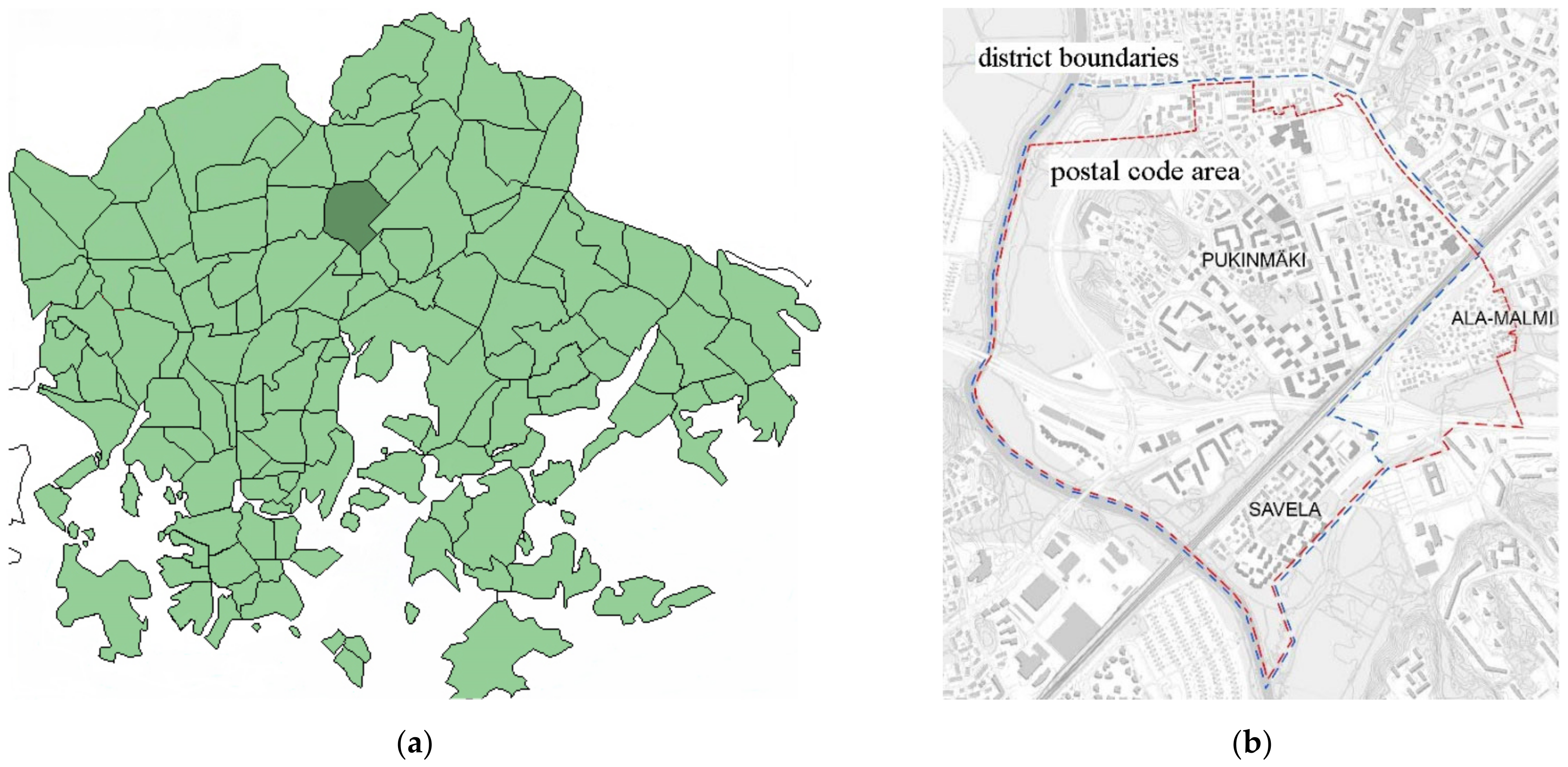
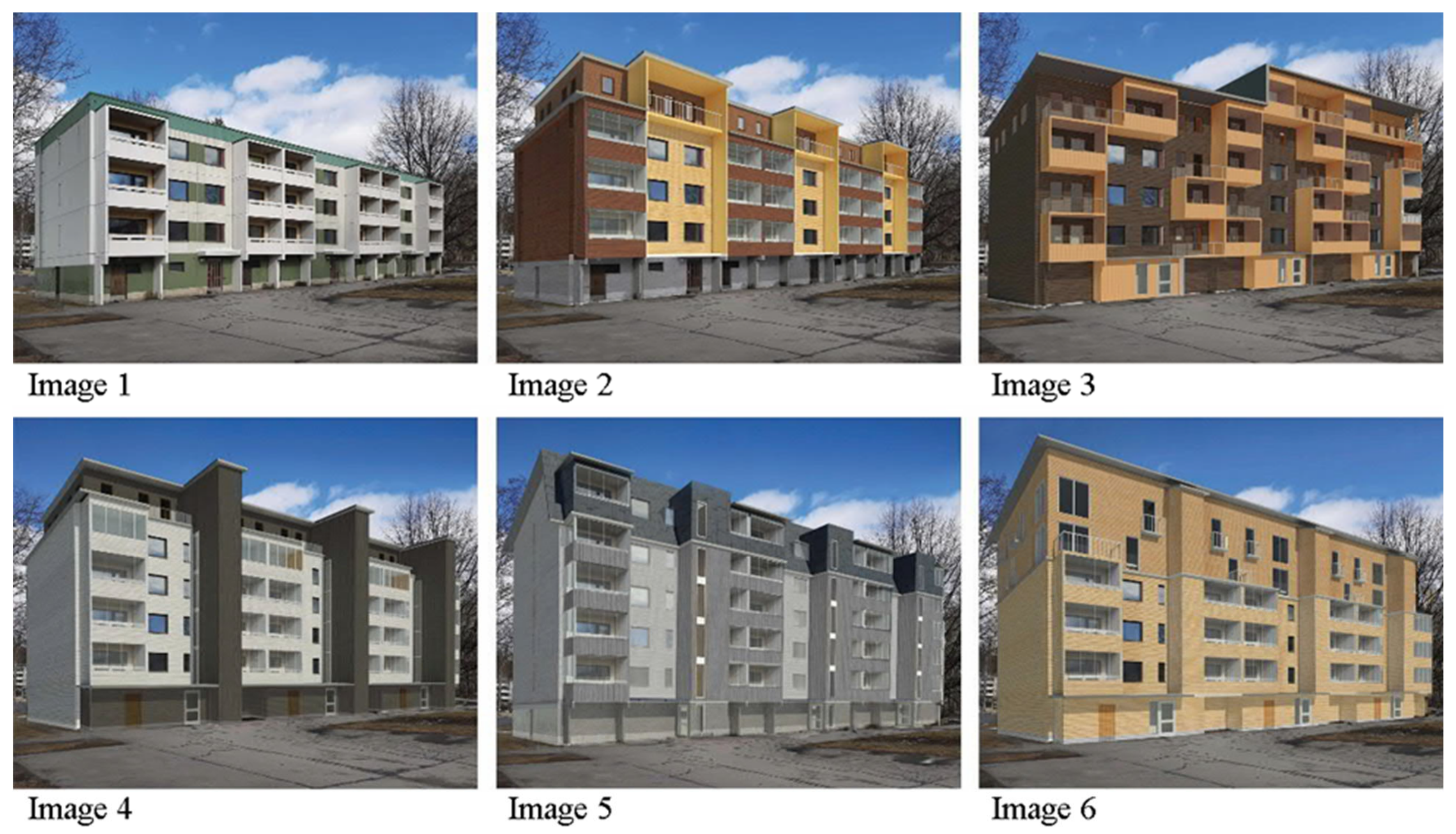
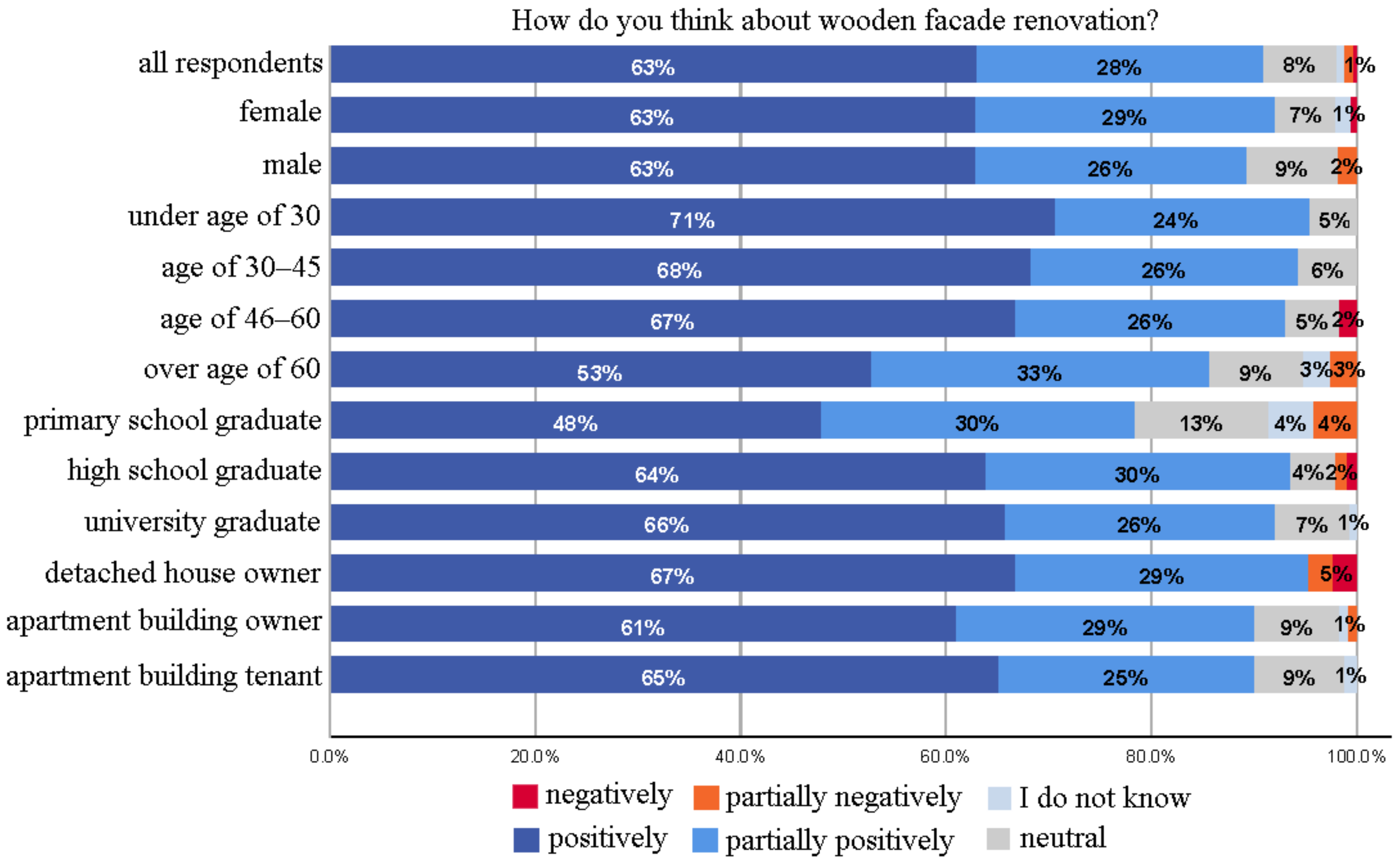
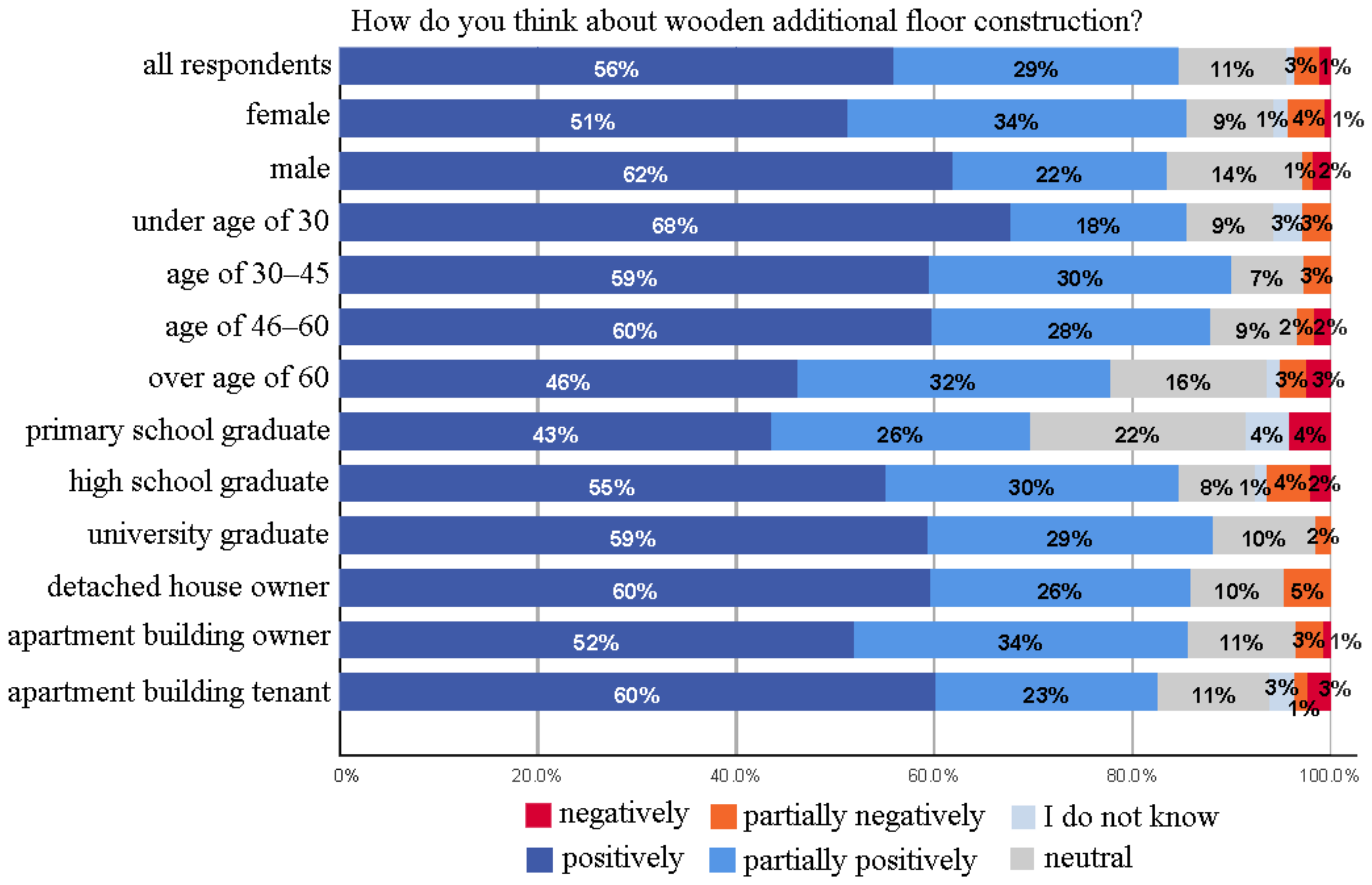




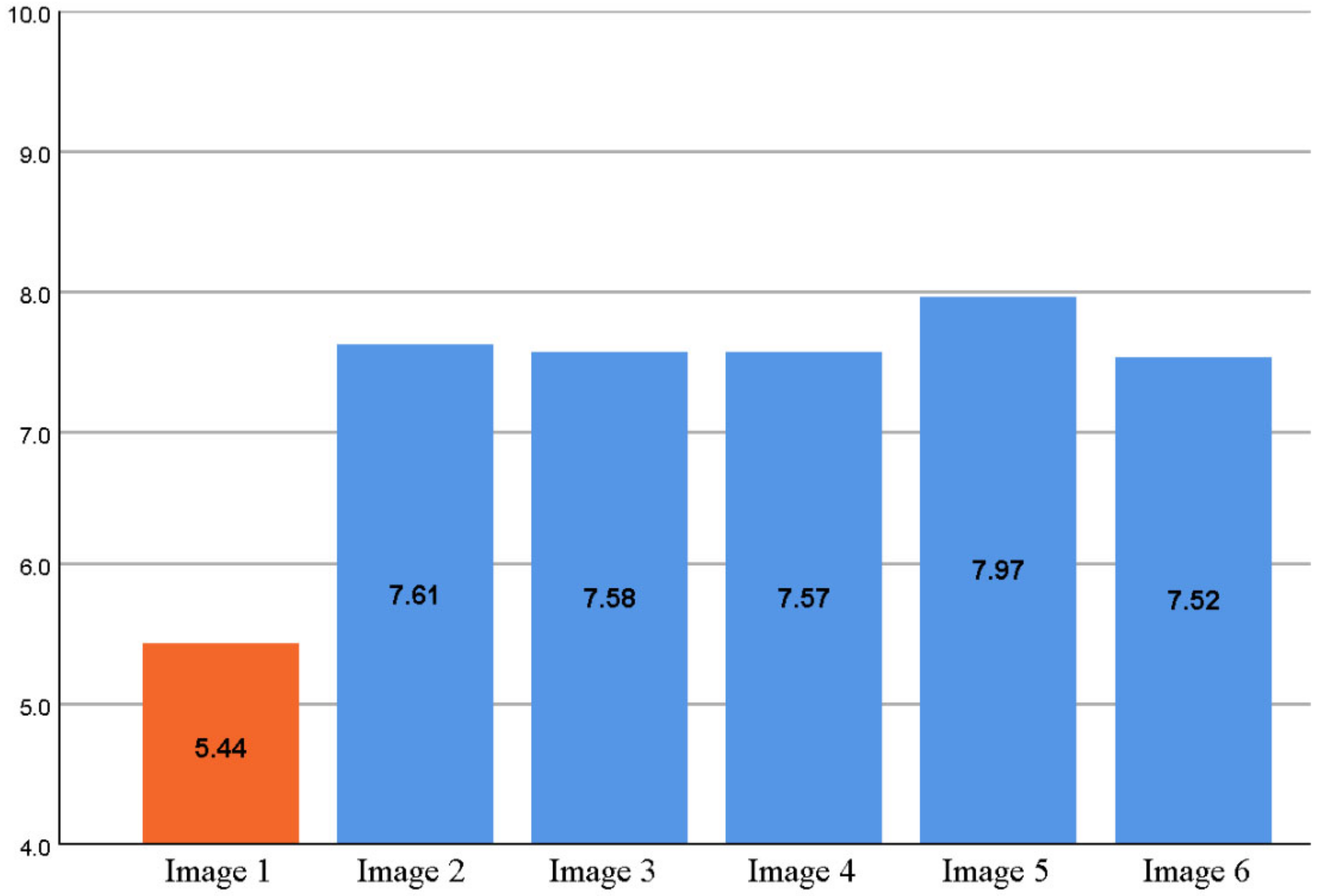
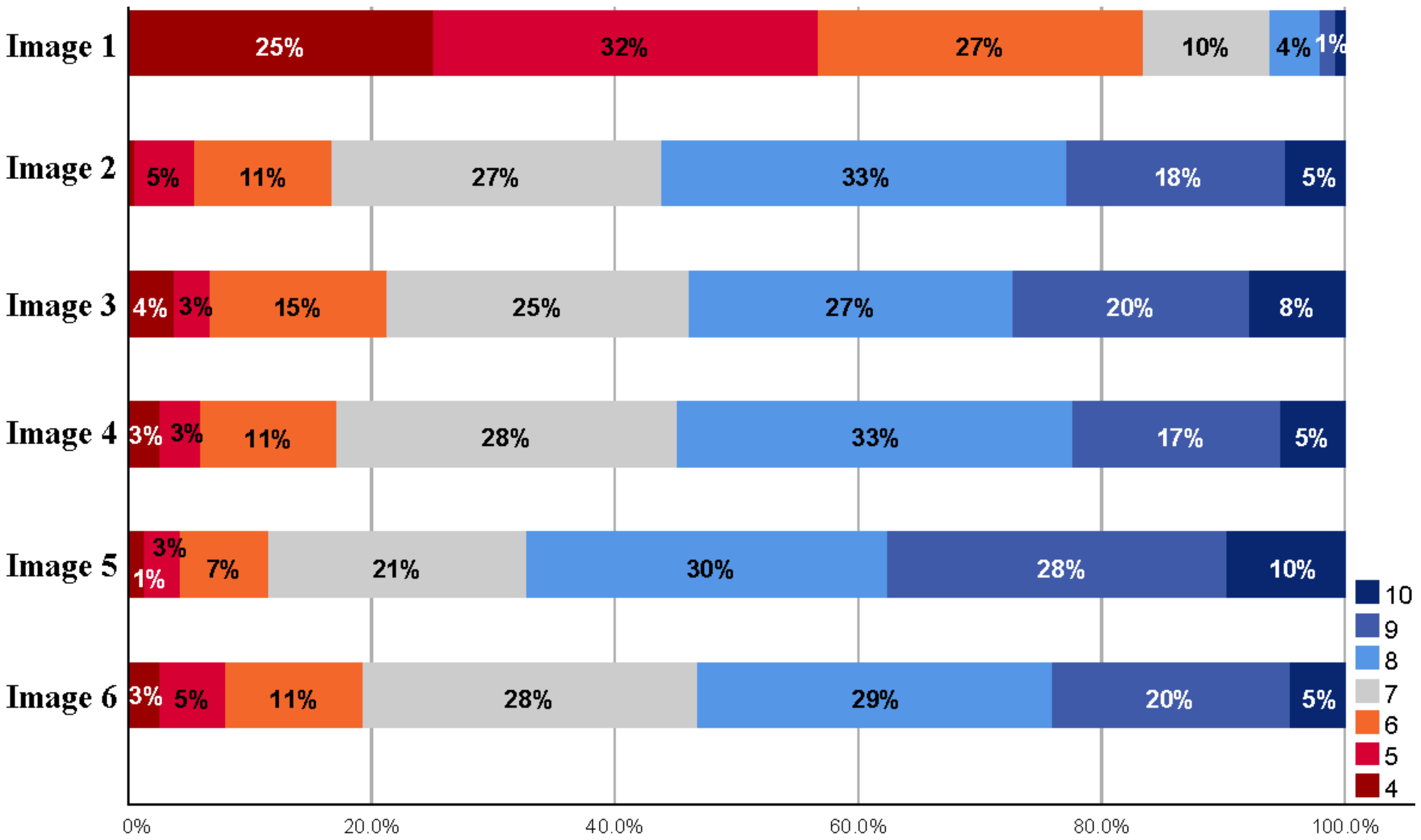
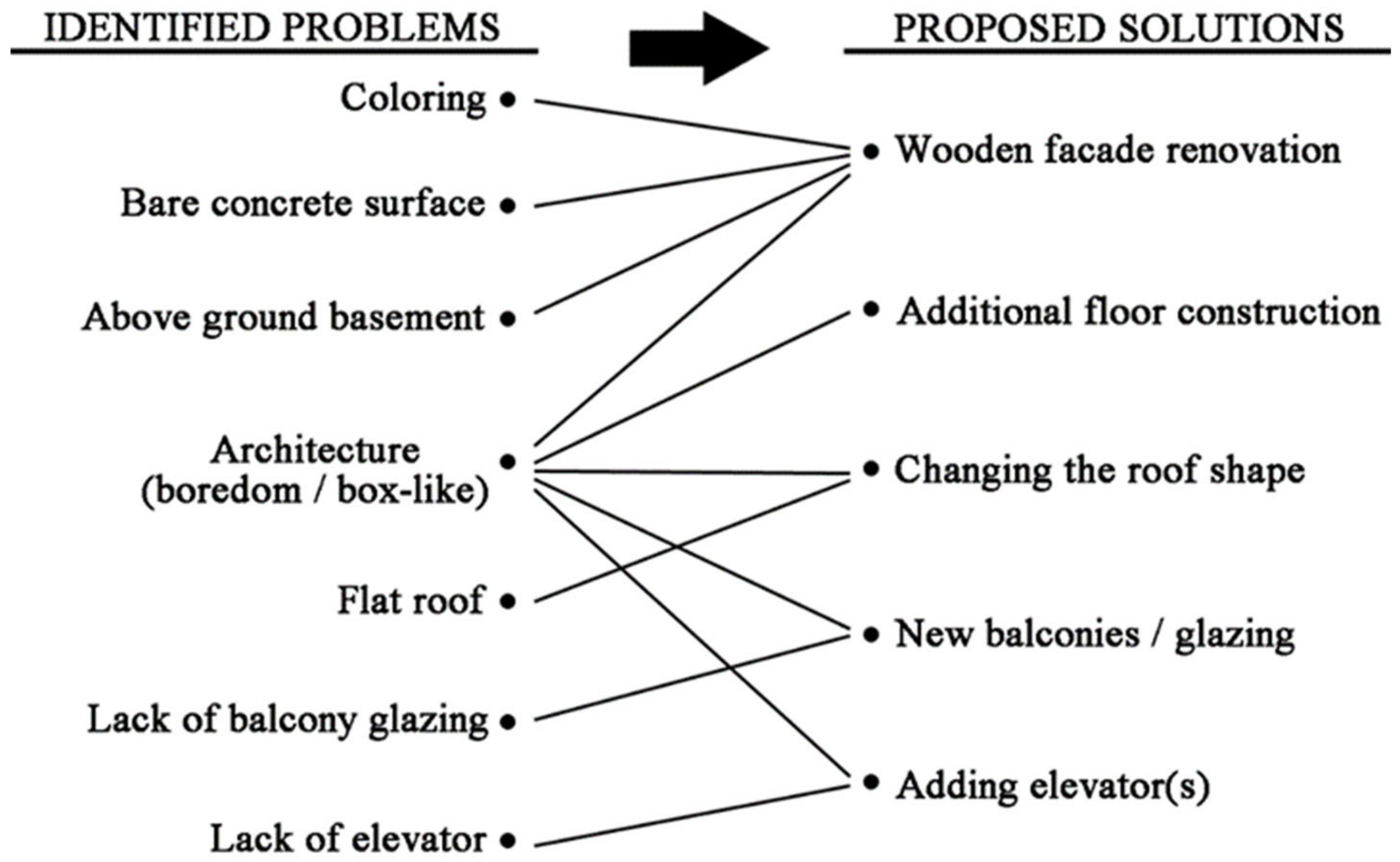
Publisher’s Note: MDPI stays neutral with regard to jurisdictional claims in published maps and institutional affiliations. |
© 2021 by the authors. Licensee MDPI, Basel, Switzerland. This article is an open access article distributed under the terms and conditions of the Creative Commons Attribution (CC BY) license (https://creativecommons.org/licenses/by/4.0/).
Share and Cite
Karjalainen, M.; Ilgın, H.E.; Metsäranta, L.; Norvasuo, M. Residents’ Attitudes towards Wooden Facade Renovation and Additional Floor Construction in Finland. Int. J. Environ. Res. Public Health 2021, 18, 12316. https://doi.org/10.3390/ijerph182312316
Karjalainen M, Ilgın HE, Metsäranta L, Norvasuo M. Residents’ Attitudes towards Wooden Facade Renovation and Additional Floor Construction in Finland. International Journal of Environmental Research and Public Health. 2021; 18(23):12316. https://doi.org/10.3390/ijerph182312316
Chicago/Turabian StyleKarjalainen, Markku, Hüseyin Emre Ilgın, Lauri Metsäranta, and Markku Norvasuo. 2021. "Residents’ Attitudes towards Wooden Facade Renovation and Additional Floor Construction in Finland" International Journal of Environmental Research and Public Health 18, no. 23: 12316. https://doi.org/10.3390/ijerph182312316
APA StyleKarjalainen, M., Ilgın, H. E., Metsäranta, L., & Norvasuo, M. (2021). Residents’ Attitudes towards Wooden Facade Renovation and Additional Floor Construction in Finland. International Journal of Environmental Research and Public Health, 18(23), 12316. https://doi.org/10.3390/ijerph182312316








